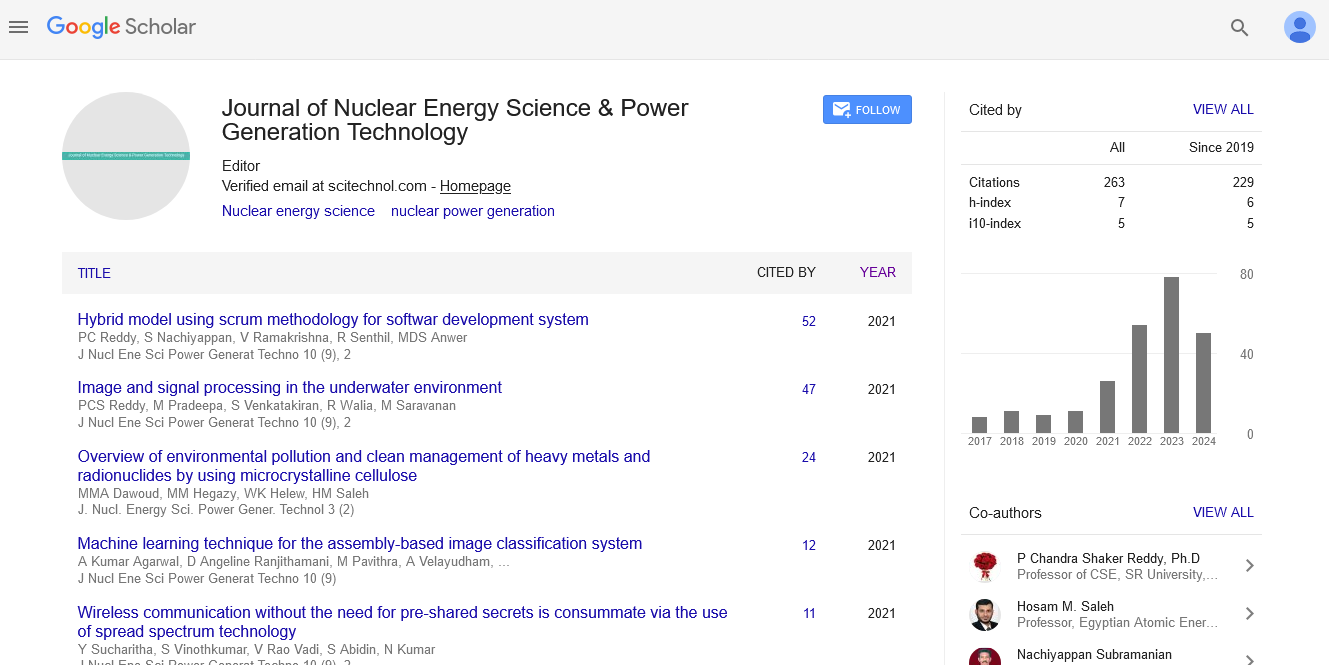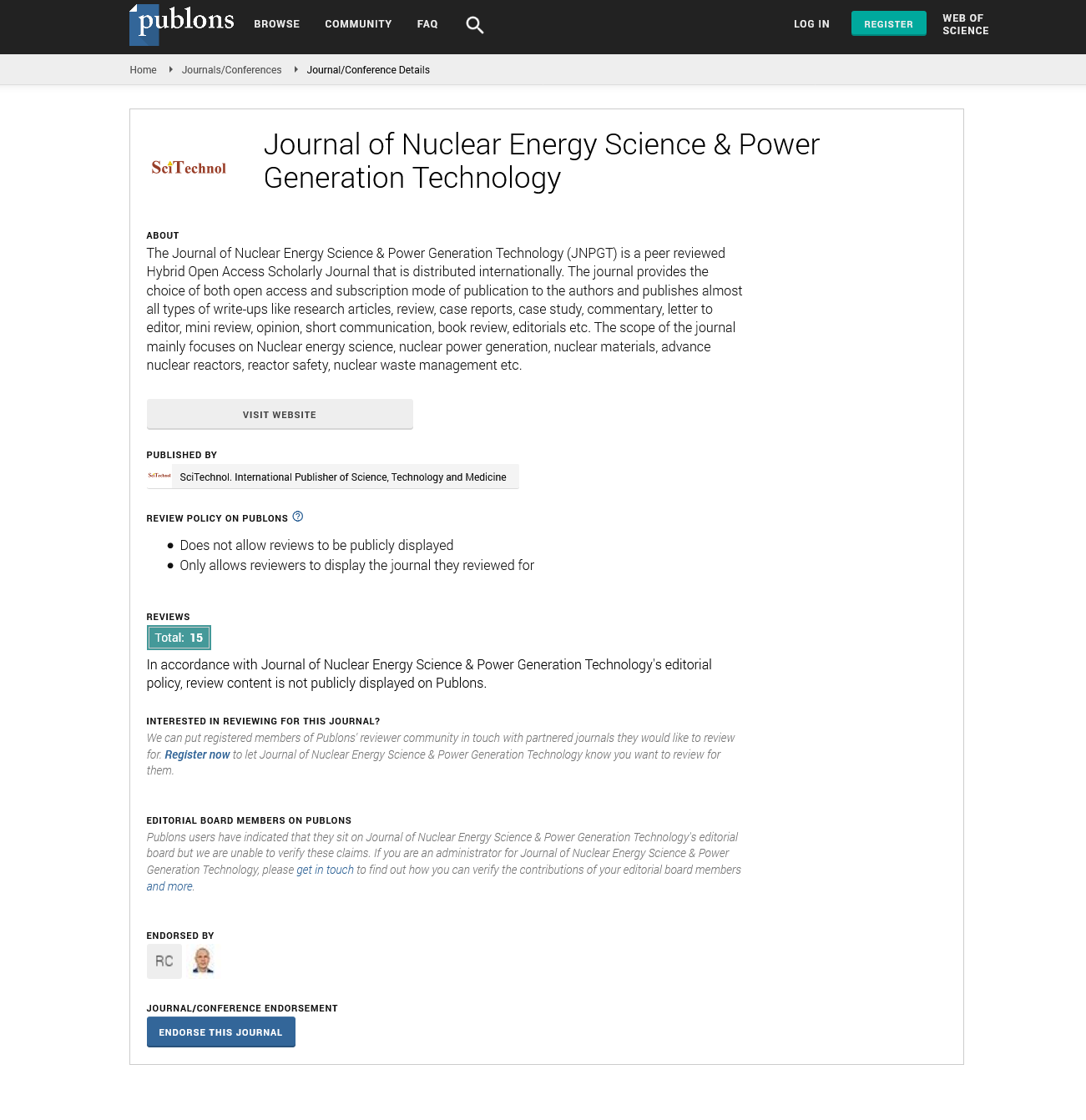Perspective, J Nucl Ene Sci Power Generat Technol Vol: 13 Issue: 6
Hybrid Energy Systems: Integrating Nuclear with Renewable Energy Sources for Grid Stability
Alex Morton*
1Department of Nuclear Engineering and Science, McMaster University, Hamilton, Canada
*Corresponding Author: Alex Morton,
Department of Nuclear Engineering and
Science, McMaster University, Hamilton, Canada
E-mail: ale.x-morton67@gmail.com
Received date: 21 October, 2024, Manuscript No. JNPGT-24-154873;
Editor assigned date: 23 October, 2024, PreQC No. JNPGT-24-154873 (PQ);
Reviewed date: 06 November, 2024, QC No. JNPGT-24-154873;
Revised date: 13 November, 2024, Manuscript No. JNPGT-24-154873 (R);
Published date: 21 November, 2024, DOI: 10.4172/2325-9809.1000427
Citation: Morton A (2024) Hybrid Energy Systems: Integrating Nuclear with Renewable Energy Sources for Grid Stability. J Nucl Ene Sci Power Generat Technol 13:6.
Description
Hybrid energy systems, which combine nuclear power with renewable energy sources such as wind and solar, are emerging as an essential solution for doing grid stability. This integration provides a balanced, efficient and low-carbon approach to energy generation, ensuring a reliable supply even during periods of fluctuating demand. Grid stability is fundamental to maintaining the reliable operation of modern power systems. The increasing diffusion of renewable energy sources has introduced variability into electricity generation. Wind and solar power, while sustainable and clean, depend on weather conditions and time of day, leading to periods of oversupply or energy deficits. This intermittency positions challenges for grid operators, who must balance supply and demand in real time. Nuclear power, known for its ability to deliver constant baseload energy, complements renewables by providing a dependable source of electricity. When paired with renewables in a hybrid energy system, nuclear energy can balance the variations of renewable generation, ensuring a seamless and stable energy supply. Hybrid systems provide a strong solution to the irregularity of renewable sources.
Nuclear power can operate continuously, supporting the grid during phases of low renewable output. Combining these two clean energy sources reduces reliance on fossil fuels, significantly lowering greenhouse gas emissions and contributing to climate change moderation. By utilizing renewable energy during peak availability and depend on nuclear power for consistent output, hybrid systems can optimize costs and reduce the need for expensive energy storage solutions. Diversifying energy sources within a hybrid system minimizes the risks associated with supply disruptions, enhancing overall energy security. Hybrid energy systems depend on innovative technologies to integrate nuclear and renewable energy sources effectively. Excess energy generated by renewables can be stored in batteries or converted into hydrogen through electrolysis, which nuclear plants can use for electricity generation during peak demand. Modern Small Modular Reactors (SMRs) are designed for flexibility, allowing them to upgrade to accommodate variations in renewable output. Nuclear reactors can use their waste heat for district heating or industrial processes, maximizing energy efficiency when renewable generation is abundant.
Building and integrating nuclear and renewable facilities require significant investments. Managing diverse energy sources requires refined grid management and control systems. The deployment of hybrid systems must navigate complex regulatory frameworks that may not yet be fully equipped to provide integrated energy solutions. However, the opportunities far outweigh these challenges. Continued advancements in energy storage technologies, supportive policies and international collaboration can accelerate the adoption of hybrid energy systems.
Conclusion
Integrating nuclear and renewable energy sources through hybrid systems provides an innovative solution to the insistent challenges of grid stability and carbon reduction. Governments, researchers and industries must collaborate to advance the development and implementation of these systems. By investing in hybrid energy technologies, the world can achieve a sustainable and adaptable energy future. Hybrid energy systems represent a transformative toward a cleaner, more sustainable energy future. By combining the reliability of nuclear power with the environmental benefits of renewables, these systems can change the growing energy demands of a carbonconstrained world. As technology progresses and costs decline, hybrid energy systems are composed to become a basis of global energy strategies.
 Spanish
Spanish  Chinese
Chinese  Russian
Russian  German
German  French
French  Japanese
Japanese  Portuguese
Portuguese  Hindi
Hindi 

